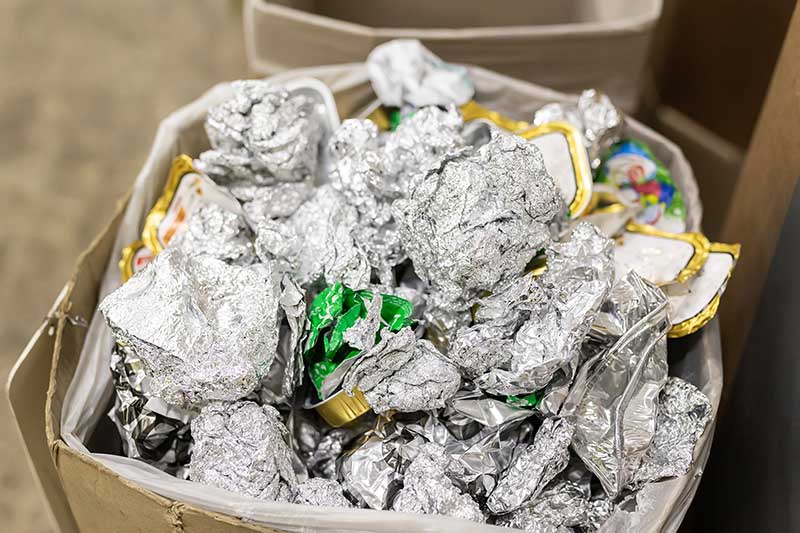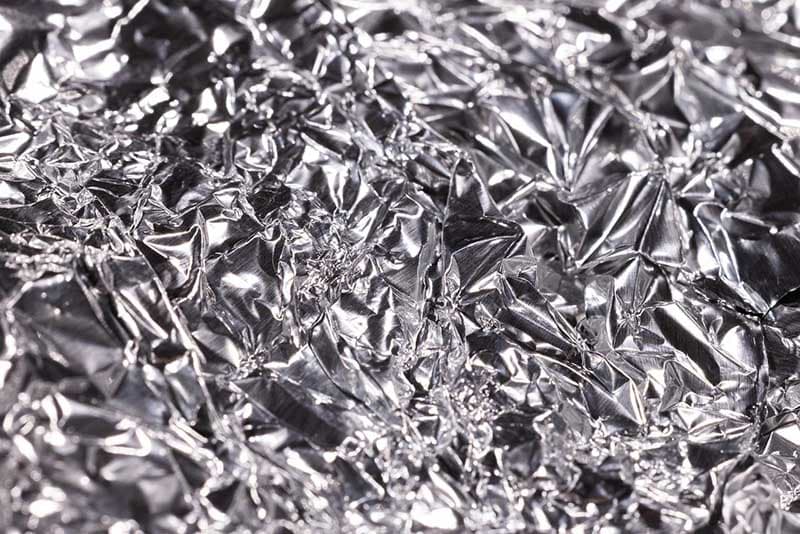Is Aluminum Foil Recyclable? Proper Disposal Methods
-
Pete Ortiz
- Last updated:

Aluminum foil, sometimes referred to as tin foil, is a common household product frequently used in cooking, preventing food from drying out, and even preserving certain foods for short periods. It is manufactured by forcing thick sheets of aluminum through a series of rollers to obtain the desired thickness of around 0.2 millimeters.
As already stated, the food industry is one of the largest consumers of aluminum foil. Together with packaging, cosmetics, and chemical processing, it uses over 75% of manufactured aluminum foils. The other 25% goes to insulation and electrical appliances and cables.
Is Aluminum Foil Recyclable?
Today, more than half a million tons of aluminum foil is produced annually, and since 98.5% of the foil is pure aluminum, can it be recycled?
The short answer is yes. But the long answer is that it’s a bit tricky.
While aluminum itself is 100% recyclable, there’s no guarantee that all recyclers will accept foils for recycling. This is because it’s usually mixed with organic food or oils, making it cost-intensive to clean before recycling. Also, since the foil is very flimsy and light, it may not be picked up in the process.
Some processes, however, have evolved to convert contaminated foil into a biofuel production ingredient.

How Is Aluminum Foil Properly Disposed Of?
You’d barely think that recyclables require any treatment before being disposed of, but you’d be mistaken. Most standard curbside recycling programs accept aluminum trays and foils and other aluminum goods. However, recycling facilities can’t accept any products that are overly filthy since the food particles might seriously damage the equipment at a typical recycling site.
The first step to preparing your foil for recycling is by cleaning. Since it’s non-porous, it can be smoothed out and rinsed like any other kitchen item. Clean off any leftover material, allow it to dry, roll it into a ball, and then add to other pieces of foil until it attains a sizable size. This helps prevent the smaller pieces from falling off or getting stuck during recycling.
Afterward, put it into the recycling bin with your cans and bottles. You’ll also want to check with your local municipality for exact guidelines that apply to recycling aluminum. If they don’t accept it, a convenient recycling locator can help you locate a place close by that will.
How Is Aluminum Recycled?
After you’ve placed your aluminum items in a recycling bin, the materials are taken to a recovery center where aluminum is singled out and sorted. The aluminum is then sent to recyclers, where it’s morphed into new products. Here’s how the recycling process works:
Stage 1: Collection
Aluminum foil is collected from various homes and mixed with other drink and food packaging. Typically, materials collected will comprise drink cans, aerosol cans, and aluminum foil.
Collection can be either through garbage collection centers or skilled businesses and individuals.
Stage 2: Sorting
Collected materials are then taken to recovery facilities or transfer stations for sorting. Here, paper, plastic, and other non-aluminum products are removed. After sorting, aluminum foils get cleaned and eventually compressed into bales.
Stage 3: Shredding
After sorting, aluminum is shredded or crushed into small pieces to reduce its volume.
Stage 4: Melting
Shredded aluminum gets loaded in a high-temperature furnace and melted down at 1,220 degrees Fahrenheit.

Stage 5: Removal of byproducts
The molten mixture then gets purified by getting rid of the dross formed during melting. Dross is a mass of solid impurities floating on molten metals. This can be done either mechanically or by use of a gas-fired rotary furnace.
Stage 6: Formation of alloy
This is done by adding metals such as silicon, magnesium, or copper to the molten mixture. The specific formulas for alloys are chosen based on the uses of recycled aluminum. For instance, adding copper and magnesium increases its strength substantially but at the cost of susceptibility to corrosion.
Stage 7: Compounding
Molten metal is then cast into large blocks called ingots.
Stage 8: Rolling
Ingots are then transported to manufacturing plants and fed into rolling mills, creating thin aluminum sheets that can be made into new aluminum products such as cans, etc.
Rolling ensures the sheets have greater strength and flexibility.
Why Is Recycling Important?
1. Saves Energy
About 90% of the energy needed to extract aluminum from the Earth is saved through aluminum recycling. Therefore, the energy used to recycle nine cans is equivalent to that required to produce one aluminum can.
2. Reduces Greenhouse Emissions
During the process of extracting aluminum, greenhouse gasses are emitted, which, when released into the atmosphere, can be harmful, especially carbon dioxide, nitrogen, and sulfur oxides.
Carbon dioxide contributes about 76% of greenhouse gas emissions. Also, not to forget sulfur dioxide and nitrogen oxide, which contribute to acid rain that can affect both ground and surface water. Eventually, this affects not only aquatic life but also humans.
Luckily, this can be avoided by recycling. Recycling aluminum reduces emissions., saving the earth from warming up and sensitive ecosystems from going extinct.
3. It Is Profitable
Another reason you should recycle aluminum is that it benefits both you and your company. Production companies, for instance, spend less on raw materials, making it easier for them to pocket more profits.
When it comes to you, you can always benefit from selling your aluminum foils for money. For example, homeowners get paid around 30 cents per medium-sized ball of aluminum foil or can.

4. Prevents Depletion of a Valued Commodity
Since aluminum comes from Bauxite, you’ll have to mine it. Seeing the tons of aluminum used yearly, you can comfortably tell there’s a significant reliance on Bauxite.
By recycling, we can now avoid reliance on Bauxite and exhaustion of natural resources like forests covering mining areas.
5. Reduces Landfills
We can all agree that waste management has become a huge problem in most countries. The US spends around $53 per every ton of landfill waste, and unfortunately, by 2035, no landfills will be left.
Most aluminum cans thrown away or not recycled will find themselves in landfills. But by recycling, you’ll reduce pressure on these landfills.
6. Continuous Use
Another benefit of recycling aluminum is the possibility of unceasing use. Recycling other products like paper is a good idea, but, in time, you won’t be able to recycle a certain material again.
With aluminum, this is a different story. You can recycle aluminum infinitely without affecting the quality of the end product.
Final Words
Aluminum foil is a recyclable product that can be transformed into cans and trays through an industrial process. However, ensure you submit clean foil for it to be accepted. While you may think your efforts are minute, you are saving energy, reducing global pollution, and improving sustainability through recycling.
Featured Image Credit: Gorloff-KV, Shutterstock
Contents


